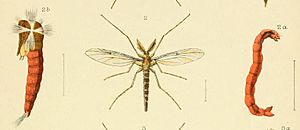New Zealand midge facts for kids
Quick facts for kids New Zealand midge |
|
|---|---|
 |
|
| Pupa (left), adult (center), larva (right) | |
| Scientific classification | |
| Genus: |
Chironomus
|
| Species: |
zealandicus
|
Chironomus zealandicus, often called the New Zealand midge or non-biting midge, is a type of insect. It belongs to the Chironomidae family. Its worm-like young, called larvae, are known as blood worms. This is because they are red and have long blood gills.
Contents
What is the New Zealand Midge?
The common New Zealand midge is a two-winged insect. It does not bite, unlike some other insects. People sometimes confuse them with mosquitoes because they look quite similar. Male midges have feathery antennae, while females do not. These special antennae help the male midge move around in water.
The midge's body is usually black or dark. It has segmented parts, especially on its main body (abdomen). You might also see green or yellow stripes on it. An adult midge is about 5mm long. The larvae are bright red and have long blood gills on their bodies.
Where Do New Zealand Midges Live?
Chironomus zealandicus is a native insect to New Zealand. This means it naturally comes from there. It is also endemic, which means it is found only in New Zealand. Hudson first reported this midge in 1892. Later, Frederick Hutton and Kieffer gave it its scientific name.
You can find this species mostly in freshwater areas and lakes. This includes places in the North Island and South Island. Some examples are Lake Ngaroto in Hamilton, Lake Rotoroa, and Lake Ellesmere / Te Waihora in Canterbury. They also live in other lakes and freshwater spots across the South Island.
C. zealandicus often gathers in large groups, called swarms. They live in lakes, rivers, and swamps. They prefer to breed in slow-moving or still water. You might find many of them in areas made by humans. These midges can even survive in polluted water. This is because they have a special protein called myoglobin. Myoglobin helps them live in stagnant water with low oxygen. In New Zealand, they are common near West Coast glaciers, hot springs, and seashores.
Life Cycle of the New Zealand Midge
The New Zealand midge goes through four stages in its life. These stages are egg, larva, pupa, and adult. Midges often breed in large groups in lakes or still water. This helps the young stages grow.
Female midges can lay up to 3000 eggs at once. These eggs are covered in a jelly-like substance. This jelly helps them stick to things in the water, like sticks or riverbanks. Eggs that don't stick will sink to the bottom. But they can still hatch there.
The egg stage lasts about 2 to 7 days. After hatching, the tiny larva eats the jelly for a few days. Then, it digs into the mud or other material to make a home. Most of the larval stage is spent inside a tube made of silt. During this time, they turn red, which is why they are called "blood worms." This stage lasts 2 to 7 weeks. The speed depends on the water temperature, which changes with the seasons.
After the larval stage, they become pupae. The pupa also creates burrows in the mud. It lives inside these tubes. The pupa stage lasts up to 3 days. Then, the pupa swims to the surface. It stays on the surface for several hours until the adult midge comes out.
The adult stage is very short, lasting a maximum of 5 days. During this time, adults gather in swarms at night to breed. Then, they die. If the water temperature and season are just right, the whole life cycle can be completed in just two weeks!
What Do New Zealand Midges Eat?
Adult New Zealand midges do not eat at all. This is why they have such a short life. They are known as "non-biters." The larvae, however, are filter feeders. They use their long blood gills to filter oxygen and tiny food particles from the water.
New Zealand midges have many ways to find food. This is because there are so many different kinds of plants and animals in their habitats. They can get nutrients from algae, tiny living things (microorganisms), small animals without backbones (invertebrates), water plants (macrophytes), and even decaying wood.
Who Eats New Zealand Midges?
New Zealand midges are a food source for many animals. River fish and other water animals, like native minnows, eat them. This happens at all stages: larva, pupa, and adult. For example, small trout will come to the surface on warm nights to eat adult midges in swarms.
Other small animals, like spiders and insects (arthropods), also prey on midges. This usually happens by chance, if a midge swarm lands nearby or gets caught in a web.
Sometimes, midge larvae can have deformities in their head capsules. A study by Jeyasingham & Ling showed that these deformities increased during summer. This might be due to the season, genetic reasons, or chemicals in the mud where they live.

